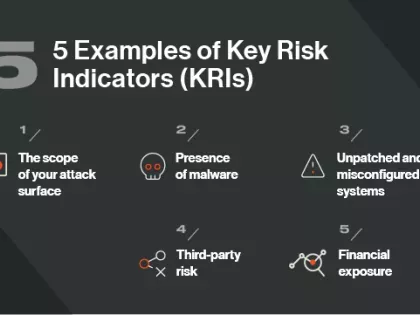Cybersecurity Risk Assessment Tools You Can Use Year-Round

When it comes to improving cybersecurity at your organization, there are some fixes that you can undertake with very little preparation. More robust risk remediation efforts, however, usually start with a cybersecurity risk assessment.
These assessments are commonly offered by third-party consultants, sometimes as a stand-alone service and sometimes as the first step in a larger end-to-end cybersecurity engagement.
No matter how they’re packaged, cybersecurity risk assessments offered by third parties are limited in scope; they only identify risks and associated insights for a given point in time. They’re also expensive, and can be disruptive to day-to-day IT operations. For these reasons, many businesses choose to replace or supplement third-party consultative engagements with do-it-yourself cybersecurity risk assessments.
Year-round cybersecurity risk assessments are possible thanks to SaaS platforms which offer continuous monitoring, automated testing, and user-friendly dashboards and reports.
As a result of their automation, these services can offer ongoing risk insights during the periods between major risk assessment engagements or potentially replace those engagements entirely, depending on the requirements of the business.
Let's break down some of the software that can be utilized by IT and cybersecurity teams to perform their own cybersecurity risk assessments.
Editor’s note: While we discuss a few different software products in this post, Bitsight does not necessarily endorse the use of these specific solutions.
Vulnerability Assessment Platforms
Vulnerability assessment software is designed to continuously scan IT assets in order to identify security concerns. Some of these solutions can be implemented on-premise, but many make use of the scalability and compute power of the cloud. Leaders in this space include Qualys, Tenable, and Rapid7.
These platforms are primarily used by IT and security technicians, and as a result may require resources from those teams or from a managed security services provider (MSSP) to set up, operate, and maintain. However, once implemented, many vulnerability assessment platforms include simple dashboards and reports to help executives stay up-to-date on their cyber risk profile.
For those seeking a cybersecurity risk assessment for compliance reasons, many vulnerability assessment platforms include built-in scans and workflows for various regulations.
Vendor-provided Assessment Tools
When assessing the cyber risk of an IT system, it can be tempting to shell out for a comprehensive solution that analyzes the system as a whole. For those working within a tight budget, however, it can be useful to break down the system into its component parts.
The vendors that provide the different components of your IT environment — workstations, servers, routers, mobile devices, operating systems, applications, etc. — often provide tools for scanning their own products for vulnerabilities and decreasing cyber risk.
Microsoft is one example. Their Security Compliance Toolkit can be downloaded for free and used to scan Windows and other Microsoft products, then bring them in line with their latest security recommendations.
Assessing IT components on a manufacturer-by-manufacturer basis isn’t quick or easy, but it is inexpensive — most providers will offer these tools at no cost to their customers. As part of a larger cybersecurity risk assessment, this kind of analysis can be extremely valuable.
Breach & Attack Simulation Tools
Penetration tests (a.k.a. pen tests) are an important part of comprehensive cybersecurity risk assessments. In these tests, an agent will attempt to penetrate your system under controlled conditions, bypass security measures, and gain access in order to identify vulnerabilities.
However, many businesses rely on third parties for their penetration testing needs, and like other parts of the assessment process, these tests are expensive and produce only point-in-time results.
A new type of software has come onto the scene in recent years to supplement pen tests and provide a more continuous, DIY version of pen-test-style risk insights. Breach and attack simulation (BAS) software, as it's come to be called, is offered by providers like Threatcare and Cymulate.
BAS tools continuously “attack” your systems using automated means informed by the latest threat intelligence. Though they can’t be relied upon to deliver the same level of insight as a human pen tester, they can help fill in the gaps between pen tests and provide a deeper understanding of cybersecurity risk.
Security Ratings
Security ratings are a data-driven, dynamic measurement of an organization’s cybersecurity performance. Ratings are derived from objective, verifiable information and created by independent organizations.
Because they don’t require deep access to a system or its proprietary credentials, security ratings have historically been used to support third-party risk management (TPRM) efforts. An organization can use these ratings to determine how secure each of their vendors are at a glance.
Recently, many organizations have turned the lens of security ratings on themselves in order to support their own security performance management initiatives. Security ratings from providers like Bitsight offer insight into compromised systems, user behavior, patching and other cyber diligence factors, and reported breaches. These insights are synthesized into one comprehensive rating, which is refreshed on a daily basis.
Security ratings offer a distinct advantage over other vulnerability assessment tools as they do not require integration into an IT system to work effectively, making them more convenient to utilize.
Importantly, security ratings also combine peer, competitor, and industry performance into their calculations. Using a tool like Bitsight Security Ratings allows IT and security leaders to prioritize the resources they put into remediation efforts based on how they compare to top performers or their industry as a whole.
Using some combination of continuous, automated tools, it’s possible to maintain a consistently clear and accurate picture of cybersecurity risk. As you remediate the issues identified in your assessment, you can be sure that no greater threats are arising in your blind spots.


